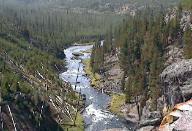
The Gibbon River has it’s beginnings in the center of Yellowstone National Park, at Grebe Lake. After leaving Grebe Lake the Gibbon River flows about 1 ½ miles into Wolf Lake, and then it meanders through some thick forest, then Virginia Meadows, and Virginia Cascades. It continues through Norris Meadows and through a fast water section before reaching Elk Park which is another large meadow. After Elk Park, it flows through still another meadow, called Gibbon Meadow with even larger trout. The Gibbon River in this section of meadows has undercut banks and a sandy bottom providing ideal habitat for trout that can easily reach 18 inches in length.
As the Gibbon River passes near the Norris Geyser Basin thermal water is added to the river but the volume of water is too small to cause a warming in the water temperature as it travels another ten miles providing excellent trout fishing before going over the 90 foot high Gibbon Falls. Below the falls is a deep canyon section where the flow eventually slows down and into the lower Gibbon Meadows.
After the meadows, the Gibbon joins the Firehole River creating the famous Madison River. This general area can be accessed from the Madison Picnic Area. The trout near the Madison Picnic Area are smart and selective probably due to the fishing pressure by families as well as seasoned anglers.
 Since the Gibbon River is not as much changed by the inflow of warmer water, it can be a better river to fish in the summer. Excellent late summer fishing can be had using terrestrials such as hoppers. Fall also offers an excellent time to fish for the larger browns that migrate up from the Madison River to spawn. Some of the spawning brown trout move all the way from Hebgen Lake upstream through the entire section of the Madison River and into the lower Gibbon River. Large trout can be taken during this time of fall spawn all the way up to the Gibbon Falls.
Since the Gibbon River is not as much changed by the inflow of warmer water, it can be a better river to fish in the summer. Excellent late summer fishing can be had using terrestrials such as hoppers. Fall also offers an excellent time to fish for the larger browns that migrate up from the Madison River to spawn. Some of the spawning brown trout move all the way from Hebgen Lake upstream through the entire section of the Madison River and into the lower Gibbon River. Large trout can be taken during this time of fall spawn all the way up to the Gibbon Falls.Recommended DVDs:
Fly Fishing Yellowstone National Park by James Marsh
View Yellowstone National Park in a larger map





